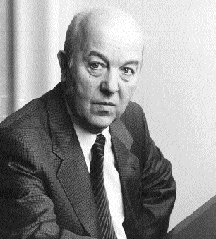Oddly enough, Panufnik's immensely challenging Sinfonia sacra (1964) came closest to the mark. Music Director Leonid Grin gave the work its due, drawing from the orchestra a reading that was both informed and spirited.
Panufnik's Sinfonia sacra is a work of strength and beauty. The composer gracefully accomplished his stated purpose of invoking religious, as well as heroic, virtues in musical terms. Composed as a tribute to Poland's Millennium of Christianity and Statehood, the Sinfonia sacra draws plentifully from this country's history.
The work's alternations between aggressive and reverential states was intended to be reflective of Poland's long-standing, dual preoccupations on the battlefields and in the churches. Musical materials were drawn from the first known hymn in the Polish language, the Bogurodzica. Panufnik's fluid, yet succinct, manner of negotiating the work's severe contrasts yield an extraordinary impact.
An important aspect of the Sinfonia sacra's allure is due to the composer's intriguing re-proportioning of the traditional four-movement symphonic plan. The work's first three movements--Visions I-III--together constitute Part One, and their combined duration is roughly equal to that of the fourth movement--Hymn--which alone makes up Part Two. The inspiring trajectory and breadth of Hymn offsets the austere, episodic nature of the first three sections and makes for an uplifting finale.
The orchestration of Sinfonia sacra sang out with clarity, framed by concise rhythmic profiles that used brass with the fineness of gilding. The orchestra's performance honored Panufnik's genius resoundingly.
The compelling peculiarities of Beethoven's Piano Concerto No. 4 make this work a new find upon each encounter. On Saturday night, though, there were discoveries that would've surprised even Beethoven, including notes he'd not written. Moravec's interpretation of this masterwork was moribund and tainted by inaccuracies.
The first movement was particularly problematic, as much due to the orchestra's limp assist as the pianist's botched passagework. Poking along at a lukewarm tempo that bordered on neutrality, the performance contained only trace elements of this movement's magnificent reasoning and lyricism. The orchestra's accompaniments were treadmill, and the strings' rhythmic punctuations about as lively as periods on a typewriter.
The contrasting piano-orchestra dialogues of the andante con moto featured fine sectional work by the strings, although Moravec's chordal responses were unduly weighted, more plodding than resolute and impassioned. At a brisk gallop, the finale's winning tunefulness wrapped a ribbon around the whole affair. It also included the best rapport between the soloist and orchestra.
The program's second half was given over to Shostakovich's Symphony No. 9, a work of uncharacteristic modesty by a composer known for thinking big. No wonder Stalin was peeved at Shostakovich over the symphony. The work--a commemoration of the Soviet Union's triumphant participation in the quelling of Nazi aggression--was meant to be a colossal enterprise.
What Stalin got was a trifle. Measured against any of the composer's other major efforts, the ninth falls dreadfully short. It bears only a smidgen of the emotional commitment that is typical of Shostakovich's music. By the composer's own admission, he was not able to summon the requisite zeal for an endeavor that would glorify Stalin. Taken on its own terms, the ninth is in turns delectable and moving. A caustic wit runs rampant throughout the opening Allegro. The composer heartily borrows from Prokofiev's Classical Symphony, and spoofs its courtly mannerisms at ricochet speed.
The second movement (Moderato) bears the mark of Shostakovich's great lyric capacities. Principal clarinetist Michael Corner's tender rendering of the movement's introductory phrase brought genuine emotions back into play. The music's lonely atmosphere was a genuine one. Excellent solowork continued in the work's ensuing Scherzo movement, with especially noteworthy contributions from principal bassoonist Deborah Kramer.
Historically, the ninth will likely be appreciated as a magnificent coup: Russia's greatest symphonist since Tchaikovsky honored the Soviet Union's cruelest leader with one of his least impassioned efforts. The scaled-down ambitions, coupled with such fascinating craftsmanship, testify to the composer's clarity of intent. A work so mockingly derivative of comrade Prokofiev must have seemed like a downpour of acid rain on their self-congratulatory parade.
[ Metro | Metroactive Central ]


